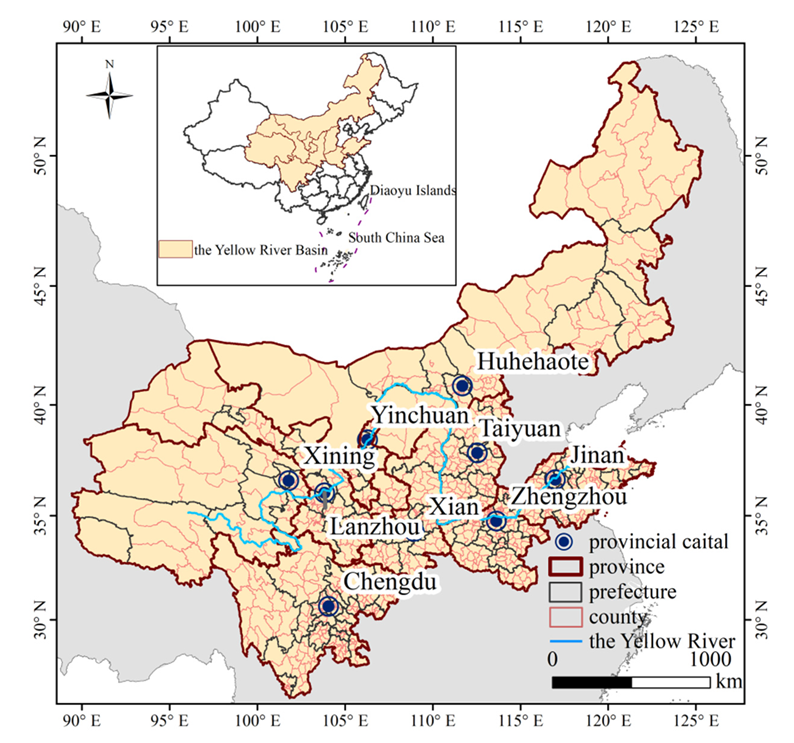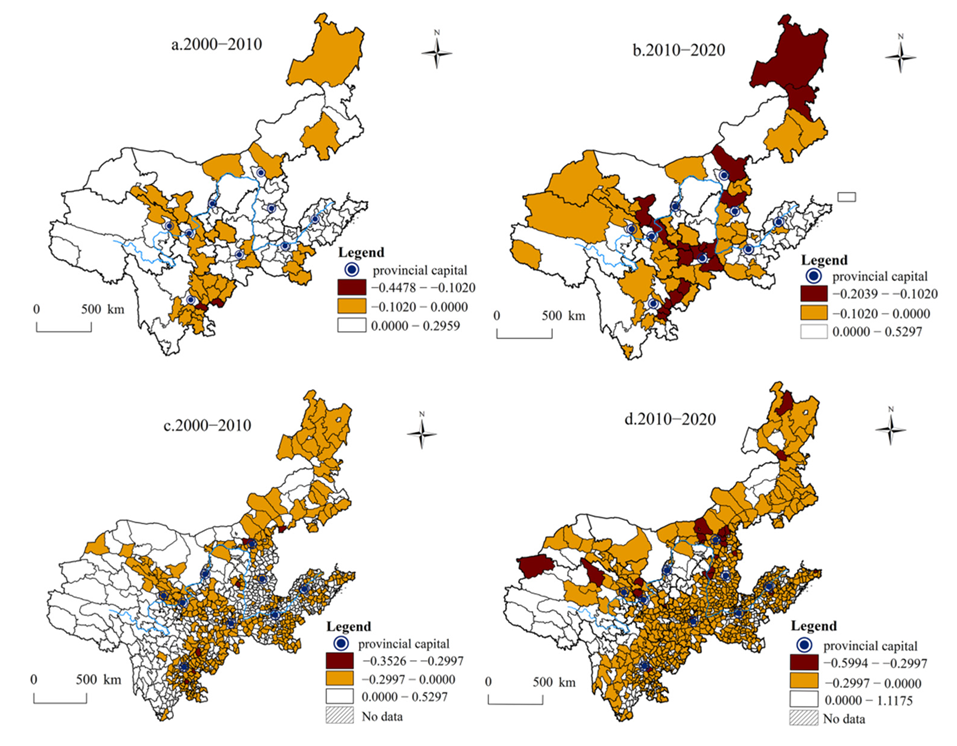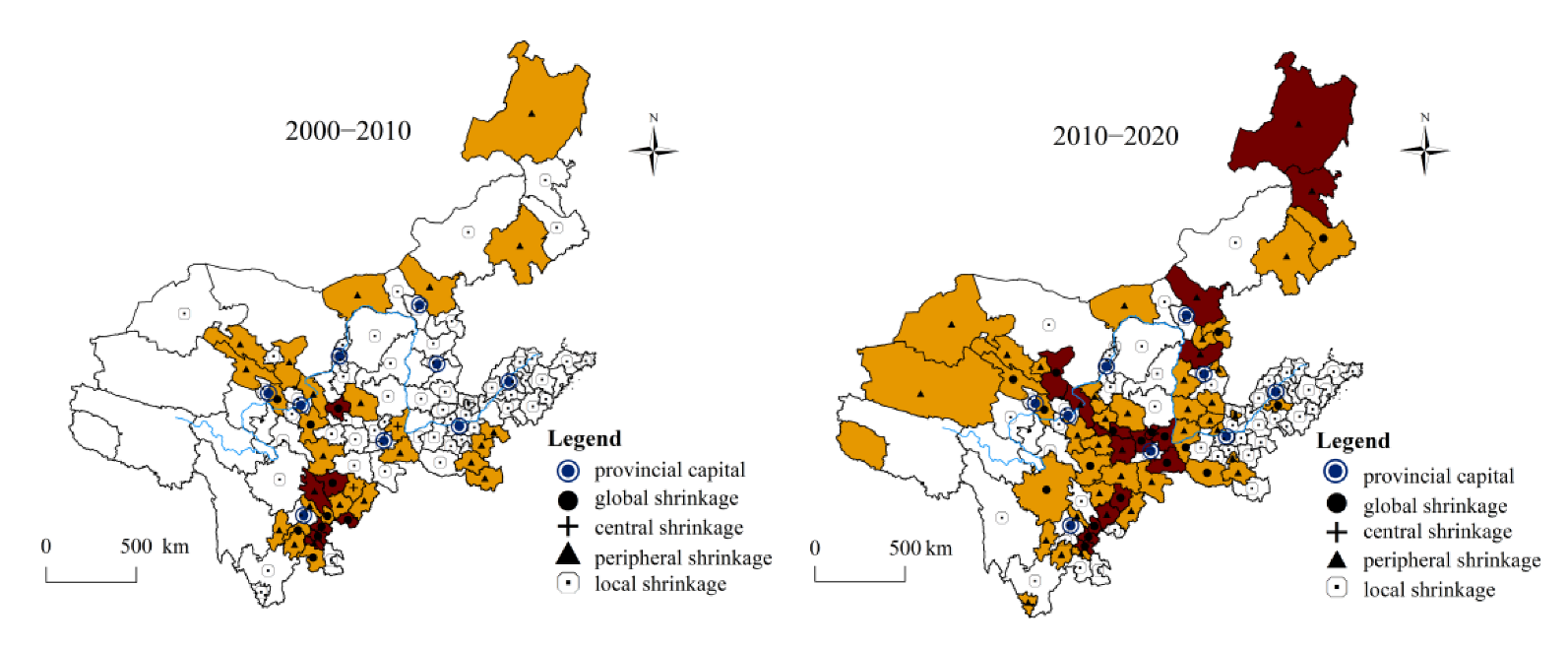Types, Modes and Influencing Factors of Urban Shrinkage: Evidence from the Yellow River Basin, China
Abstract
:1. Introduction
2. Materials and Methods
2.1. Study Area
2.2. Research Methods
2.2.1. Concept Definition and Measurement of Urban Shrinkage
2.2.2. Multiple Linear Regression Model
2.2.3. Sorting Model
2.3. Indicator System and Data Sources
2.3.1. Selection of Influencing Factors of Urban Shrinkage
2.3.2. Data Sources
3. Results
3.1. Temporal Evolution and Types of Urban Shrinkage in the Yellow River Basin
3.2. Spatial Patterns and Modes of Urban Shrinkage in the Yellow River Basin
3.3. Factors Influencing Urban Shrinkage in the Yellow River Basin
3.3.1. The Role of Various Influencing Factors in Urban Shrinkage
3.3.2. Economic Development Strength and Speed and Urban Shrinkage
3.3.3. Demographic Ageing Level and Urban Shrinkage
3.3.4. Industrial Structure Transformation and Urban Shrinkage
3.3.5. High-Speed Rail Opening and Urban Shrinkage
3.3.6. Urban Environment, Facility Construction Level and Urban Shrinkage
4. Discussion
4.1. Validation and Supplementation of Urban Shrinkage Measures Based on Nighttime Lighting Data
4.2. A Comparison of Typical Patterns of Urban Shrinkage in the Yellow River Basin and Western Developed Countries
4.3. Analysis of the Influencing Factors of Urban Shrinkage in the Yellow River Basin in the Context of China’s Urban Development
4.4. Urban Shrinkage Brings Opportunities and Challenges to Achieving High-Quality Development
5. Conclusions
Author Contributions
Funding
Institutional Review Board Statement
Informed Consent Statement
Data Availability Statement
Acknowledgments
Conflicts of Interest
References
- Nelle, A.; Großmann, K.; Haase, D.; Kabisch, S.; Rink, D.; Wolff, M. Urban shrinkage in Germany: An entangled web of conditions, debates and policies. Cities 2017, 69, 116–123. [Google Scholar] [CrossRef]
- Rieniets, T. Shrinking Cities: Causes and Effects of Urban Population Losses in the Twentieth Century. Nat. Cult. 2009, 4, 231–254. [Google Scholar] [CrossRef]
- Lima, M.; Thompson, C.; Aspinall, P. Friendly Communities and Outdoor Spaces in Contexts of Urban Population Decline. Land 2020, 9, 439. [Google Scholar] [CrossRef]
- Lee, J.; Park, Y.; Kim, H. Evaluation of Local Comprehensive Plans to Vacancy Issue in a Growing and Shrinking City. Sustainability 2019, 11, 4966. [Google Scholar] [CrossRef] [Green Version]
- Häußermann, H.; Siebel, W. Die Schrumpfende Stadt und Die Stadtsoziologie; Soziologische Stadtforschung: Wiesbaden, Germany, 1988; pp. 78–94. [Google Scholar]
- Meng, X.; Long, Y. Shrinking cities in China: Evidence from the latest two population censuses 2010–2020. Environ. Plan. A Econ. Space 2022, 54, 449–453. [Google Scholar] [CrossRef]
- Gunko, M.; Eremenko, Y.; Batunova, E. Planning Strategies in the Context of Urban Shrinkage in Russia: Evidence from Small and Medium-sized Cities. Mir Ross. Universe Russ. 2020, 29, 121–141. [Google Scholar]
- Meng, X.; Jiang, Z.; Wang, X.; Long, Y. Shrinking cities on the globe: Evidence from LandScan 2000–2019. Environ. Plan. A Econ. Space 2021, 53, 1244–1248. [Google Scholar] [CrossRef]
- Wang, R.; Wang, C.; Zhang, S.; Ding, X. A study on the spatial and temporal evolution of urban shrinkage and its influencing factors from a multidimensional perspective: A case study of resource-based cities in China. PLoS ONE 2021, 16, e0258524. [Google Scholar] [CrossRef]
- Yang, Y.; Wu, J.; Wang, Y.; Huang, Q.; He, C. Quantifying spatiotemporal patterns of shrinking cities in urbanizing China: A novel approach based on time-series nighttime light data. Cities 2021, 118, 103346. [Google Scholar] [CrossRef]
- Nuissl, H.; Rink, D. The ‘production’ of urban sprawl in eastern Germany as a phenomenon of post-socialist transformation. Cities 2005, 22, 123–134. [Google Scholar] [CrossRef]
- Couch, C.; Karecha, J.; Nuissl, H.; Rink, D. Decline and sprawl: An evolving type of urban development–observed in Liverpool and Leipzig. Eur. Plan. Stud. 2005, 13, 117–136. [Google Scholar] [CrossRef]
- Blanco, H.; Alberti, M.; Olshansky, R.; Chang, S.; Wheeler, S.; Randolph, J.; London, J.; Hollander, J.; Pallagst, K.; Schwarz, T.; et al. Shaken, shrinking, hot, impoverished and informal: Emerging research agendas in planning. Prog. Plan. 2009, 72, 195–250. [Google Scholar] [CrossRef]
- Thompson, E.; de Beurs, K. Tracking the removal of buildings in rust belt cities with open-source geospatial data. Int. J. Appl. Earth Obs. Geoinf. 2018, 73, 471–481. [Google Scholar] [CrossRef]
- Pallagst, K. The planning research agenda: Shrinking cities—A challenge for planning cultures. Town Plan. Rev. 2010, 81. [Google Scholar] [CrossRef]
- Özatağan, G.; Eraydın, A. The Role of Government Policies and Strategies Behind the Shrinking Urban Core in an Expanding City Region: The Case of Izmir. Eur. Plan. Stud. 2014, 22, 1027–1047. [Google Scholar] [CrossRef] [Green Version]
- Usui, H.; Perez, J. Are patterns of vacant lots random? Evidence from empirical spatiotemporal analysis in Chiba prefecture, east of Tokyo. Environ. Plan. B Urban Anal. City Sci. 2022, 49, 777–793. [Google Scholar] [CrossRef]
- Ma, Q.; Gong, Z.; Kang, J.; Tao, R.; Dang, A. Measuring Functional Urban Shrinkage with Multi-Source Geospatial Big Data: A Case Study of the Beijing-Tianjin-Hebei Megaregion. Remote Sens. 2020, 12, 2513. [Google Scholar] [CrossRef]
- Karp, D.; Bagchi-Sen, S.; Rogerson, P. Not all shrinking places are similar: The variegated nature of population decline in the United States. Appl. Geogr. 2022, 138, 102581. [Google Scholar] [CrossRef]
- Mallach, A.; Haase, A.; Hattori, K. The shrinking city in comparative perspective: Contrasting dynamics and responses to urban shrinkage. Cities 2017, 69, 102–108. [Google Scholar] [CrossRef]
- Martinez-Fernandez, C.; Audirac, I.; Fol, S.; Cunningham-Sabot, E. Shrinking cities: Urban challenges of globalization. Int. J. Urban Reg. Res. 2012, 36, 213–225. [Google Scholar] [CrossRef]
- Li, J.; Zhang, H.; Sun, Z. Spatiotemporal variations of land urbanization and socioeconomic benefits in a typical sample zone: A case study of the Beijing-Hangzhou Grand Canal. Appl. Geogr. 2020, 117, 102187. [Google Scholar] [CrossRef]
- Niu, W.; Xia, H.; Wang, R.; Pan, L.; Meng, Q.; Qin, Y.; Li, R.; Zhao, X.; Bian, X.; Zhao, W. Research on Large-Scale Urban Shrinkage and Expansion in the Yellow River Affected Area Using Night Light Data. ISPRS Int. J. Geo-Inf. 2021, 10, 5. [Google Scholar] [CrossRef]
- Jin, Z.; Wang, C.; Yu, S.; Zhang, S.; Ding, X. Spatiotemporal evolution and influencing factors of urban shrinkage in the Yellow River Basin, China. PLoS ONE 2022, 17, e0264236. [Google Scholar] [CrossRef]
- Haase, A.; Bernt, M.; Großmann, K.; Mykhnenko, V.; Rink, D. Varieties of shrinkage in European cities. Eur. Urban Reg. Stud. 2016, 23, 86–102. [Google Scholar] [CrossRef]
- Wolff, M.; Wiechmann, T. Urban growth and decline: Europe’s shrinking cities in a comparative perspective 1990–2010. Eur. Urban Reg. Stud. 2018, 25, 122–139. [Google Scholar] [CrossRef]
- Segers, T.; Devisch, O.; Herssens, J.; Vanrie, J. Conceptualizing demographic shrinkage in a growing region–Creating opportunities for spatial practice. Landsc. Urban Plan. 2020, 195, 103711. [Google Scholar] [CrossRef]
- Yang, Z.; Dunford, M. City shrinkage in China: Scalar processes of urban and hukou population losses. Reg. Stud. 2018, 52, 1111–1121. [Google Scholar] [CrossRef]
- Zhang, Y.; Fu, Y.; Kong, X.; Zhang, F. Prefecture-level city shrinkage on the regional dimension in China: Spatiotemporal change and internal relations. Sustain. Cities Soc. 2019, 47, 101490. [Google Scholar] [CrossRef]
- Guo, F.; Qu, X.; Ma, Y.; Tong, L. Spatiotemporal pattern evolution and influencing factors of shrinking cities: Evidence from China. Cities 2019, 119, 103391. [Google Scholar] [CrossRef]
- Wang, S.; Guo, J.; Luo, X.; Liu, J.; Gu, Z. Spatial Impact of High-speed Railway on the Urban Scale:An Empirical Analysis from Northeast China. Chin. Geogr. Sci. 2020, 30, 366–378. [Google Scholar] [CrossRef]
- Guan, D.; He, X.; Hu, X. Quantitative identification and evolution trend simulation of shrinking cities at the county scale, China. Sustain. Cities Soc. 2021, 65, 102611. [Google Scholar] [CrossRef]
- Chen, Z.; Yu, B.; Yang, C.; Zhou, Y.; Yao, S.; Qian, X.; Wang, C.; Wu, B.; Wu, J. An extended time series (2000–2018) of global NPP-VIIRS-like nighttime light data from a cross-sensor calibration. Earth Syst. Sci. Data 2021, 13, 889–906. [Google Scholar] [CrossRef]
- Liu, C.; Yang, P. A Comparative Study on the Motivation Mechanism and Performance Characteristics of Chinese and Foreign Shrinking Cities. Mod. Urban Res. 2017, 24, 64–71. [Google Scholar] [CrossRef]
- Deng, T.; Wang, D.; Yang, Y.; Yang, H. Shrinking cities in growing China: Did high speed rail further aggravate urban shrinkage? Cities 2018, 86, 210–219. [Google Scholar] [CrossRef]
- Song, X.; Feng, Q.; Xia, F.; Li, X.; Scheffran, J. Impacts of changing urban land-use structure on sustainable city growth in China: A population-density dynamics perspective. Habitat Int. 2021, 107, 102296. [Google Scholar] [CrossRef]
- Yang, D.; Luan, W.; Yang, J.; Xue, B.; Zhang, X.; Wang, H.; Pian, F. The contribution of data-driven poverty alleviation funds in achieving mid-21st-Century multidimensional poverty alleviation planning. Humanit. Soc. Sci. Commun. 2022, 9, 179. [Google Scholar] [CrossRef]
- Dong, B.; Ye, Y.; You, S.; Zheng, Q.; Huang, L.; Zhu, C.; Tong, C.; Li, S.; Li, Y.; Wang, K. Identifying and Classifying Shrinking Cities Using Long-Term Continuous Night-Time Light Time Series. Remote Sens. 2021, 13, 3142. [Google Scholar] [CrossRef]
- You, H.; Yang, J.; Xue, B.; Xiao, X.; Xia, J.; Jin, C.; Li, X. Spatial evolution of population change in Northeast China during 1992–2018. Sci. Total Environ. 2021, 776, 146023. [Google Scholar] [CrossRef]
- Ribant, M.; Chen, X. A typology of U.S. Shrinking Cities. Prof. Geogr. 2020, 72, 152–164. [Google Scholar] [CrossRef]
- Schetke, S.; Haase, D. Multi-criteria assessment of socio-environmental aspects in shrinking cities. Experiences from eastern Germany. Environ. Impact Assess. Rev. 2007, 28, 483–503. [Google Scholar] [CrossRef]
- Dubeaux, S.; Sabot, E. Maximizing the potential of vacant spaces within shrinking cities, a German approach. Cities 2018, 75, 6–11. [Google Scholar] [CrossRef]
- Batunova, E.; Gunko, M. Urban shrinkage: An unspoken challenge of spatial planning in Russian small and medium-sized cities. Eur. Plan. Stud. 2018, 26, 1580–1597. [Google Scholar] [CrossRef]
- Lang, T. Shrinkage, Metropolization and Peripheralization in East Germany. Eur. Plan. Stud. 2012, 20, 1747–1754. [Google Scholar] [CrossRef]
- Hartt, M. The diversity of North American shrinking cities. Urban Stud. 2018, 55, 2946–2959. [Google Scholar] [CrossRef]
- Radzimski, A. Involving small landlords as a regeneration strategy under shrinkage: Evidence from two East German cases. Eur. Plan. Stud. 2017, 26, 526–545. [Google Scholar] [CrossRef]
- Knippschild, R.; Zöllter, C. Urban Regeneration between Cultural Heritage Preservation and Revitalization: Experiences with a Decision Support Tool in Eastern Germany. Land 2021, 10, 547. [Google Scholar] [CrossRef]
- Coppola, A. Projects of becoming in a right-sizing shrinking City. Urban Geogr. 2019, 40, 237–256. [Google Scholar] [CrossRef]
- Franklin, R. The demographic burden of population loss in US cities, 2000–2010. J. Geogr. Syst. 2019, 23, 209–230. [Google Scholar] [CrossRef] [Green Version]





| Variable | Variable Description |
|---|---|
| Economic development strength (GDP) | Gross National Product of base period |
| Economic development speed (GDP_G) | Gross National Product growth rate |
| Ageing degree (Ageing) | The change rate of ageing rate |
| Industrial structure transformation (Indust) | The change rate of the ratio of tertiary industry GDP to secondary industry GDP |
| High-speed railway opening (HSM) | A binary variable taking the value 1 if the city is severed by a high-speed railway and 0 in other cases |
| High-speed railway opening_economic development (HSM*GDP_G) | The interaction variable between the variable high-speed railway opening and the variable economic development speed |
| Urban air environment (PM2.5) | The average value of Z value change rate of all units in PM2.5 raster data |
| Urban natural environment (Slope) | The average value of Z value change rate of all units in DEM raster data. |
| Facility construction level (Invest) | The change rate of investment in fixed assets |
| Level | Unit | Statistic | 2000–2010 | 2010–2020 | ||||
|---|---|---|---|---|---|---|---|---|
| Shrinkage | Non-Shrinkage | Total | Shrinkage | Non-Shrinkage | Total | |||
| Prefecture | City | Number | 34 | 81 | 115 | 57 | 58 | 115 |
| Rate | 29.57% | 70.43% | 100% | 49.57% | 50.43% | 100% | ||
| County | Municipal county | Number | 308 | 354 | 662 | 503 | 159 | 662 |
| Rate | 46.53% | 53.47% | 100% | 75.98% | 24.02% | 100% | ||
| Municipal district | Number | 52 | 222 | 274 | 108 | 166 | 274 | |
| Rate | 18.98% | 81.02% | 100% | 39.42% | 60.58% | 100% | ||
| Total | Number | 360 | 576 | 936 | 611 | 325 | 936 | |
| Rate | 38.46% | 61.54% | 100% | 65.28% | 34.72% | 100% | ||
| Classification of Shrinking Degree | Division Standard | Classification of Shrinking Trajectory | Division Standard |
|---|---|---|---|
| Slight shrinkage | [−0.1020,0) (prefecture level) | Worsening shrinkage | Shrinking2 < Shrinking1 < 0 |
| [−0.2040,−0.1020) (county level) | Slowing shrinkage | Shrinking1 < Shrinking2 < 0 | |
| Severe shrinkage | [−0.2997,0) (prefecture level) | Recent shrinkage | Shrinking2 < 0 < Shrinking1 |
| [−0.5994,−0.2997) (county level) | Steady shrinkage | Shrinking1 < 0 < Shrinking2 |
| Level | Statistic | 2000–2010 | 2000–2010 | ||||
|---|---|---|---|---|---|---|---|
| Slight Shrinkage | Severe Shrinkage | Total | Slight Shrinkage | Severe Shrinkage | Total | ||
| Prefecture | Number | 27 | 7 | 34 | 40 | 17 | 57 |
| Rate | 79.41% | 20.52% | 100% | 70.18% | 29.82% | 100% | |
| County | Number | 354 | 6 | 360 | 580 | 31 | 611 |
| Rate | 98.33% | 1.67% | 100% | 94.93% | 5.07% | 100% | |
| Level | Statistic | Worsening Shrinkage | Slowing Shrinkage | Recent Shrinkage | Steady Shrinkage | Total |
|---|---|---|---|---|---|---|
| Prefecture | Number | 18 | 9 | 30 | 7 | 64 |
| Rate | 28.13% | 14.06% | 46.88% | 10.93% | 100% | |
| County | Number | 187 | 108 | 316 | 65 | 676 |
| Rate | 27.66% | 15.98% | 46.75% | 9.61% | 100% |
| Model 1 | Model 2 | |||||
|---|---|---|---|---|---|---|
| (a) | (b) | |||||
| Variables | 2000–2010 | 2010–2020 | 2000–2010 | 2010–2020 | 2000–2010 | 2010–2020 |
| GDP | 0.1163 * (1.75) | 0.1628 ** (2.49) | 0.8520 (0.66) | 3.067 ** (2.11) | 0.4334 (0.66) | 1.567 * (1.95) |
| GDP_G | 0.0067 (1.64) | 0.0379 * (1.78) | 0.0073 (0.08) | 0.8115 ** (1.78) | −0.0083 (0.08) | 0.5791 ** (2.28) |
| Ageing | −0.1990 *** (−4.14) | −0.1410 *** (−4.21) | −5.286 *** (−4.78) | −3.719 *** (−3.79) | −3.013 *** (−4.78) | −1.648 *** (−3.90) |
| Indust | 0.0691 ** (2.48) | 0.0021 (0.18) | 0.6616 (1.18) | −0.2136 (−0.79) | 0.3080 (1.18) | −0.0563 (−0.40) |
| HSM | −0.1132 *** (−2.71) | −0.15030 ** (−2.44) | −2.153 ** (−2.55) | 0.2392 (0.19) | −1.404 *** (−2.55) | 0.1563 (0.21) |
| HSM*GDP_G | 0.0258 *** (3.17) | 0.1885 *** (3.81) | 0.3892 ** (2.22) | −0.8996 (−0.84) | 0.2686 *** (2.22) | −0.4868 (−0.79) |
| PM2.5 | −0.2728 *** (−4.61) | 0.0049 * (1.95) | −3.488 *** (−2.81) | 0.0856 (1.61) | −2.008 *** (−2.81) | 0.0631 ** (2.10) |
| Slope | 0.0045 (1.48) | −0.0083 ** (−2.48) | 0.0292 (0.50) | −0.2113 *** (−3.00) | 0.0092 (0.50) | −0.1305 *** (−3.26) |
| Invest | −0.0001 (−0.08) | −0.0068 * (−1.95) | 0.0066 (0.42) | −0.0688 (−1.02) | 0.0030 (0.42) | −0.0372 (−0.90) |
| Number of observations | 115 | 115 | 115 | 115 | 115 | 115 |
| Average VIF | 2.02 | 2.62 | 2.02 | 2.62 | 2.02 | 2.62 |
| R2/Pseudo R2 | 0.4513 | 0.5040 | 0.1751 | 0.1656 | 0.1799 | 0.1463 |
Publisher’s Note: MDPI stays neutral with regard to jurisdictional claims in published maps and institutional affiliations. |
© 2022 by the authors. Licensee MDPI, Basel, Switzerland. This article is an open access article distributed under the terms and conditions of the Creative Commons Attribution (CC BY) license (https://creativecommons.org/licenses/by/4.0/).
Share and Cite
Ding, X.; Yu, S.; Miao, Y.; Wang, C.; Jin, Z. Types, Modes and Influencing Factors of Urban Shrinkage: Evidence from the Yellow River Basin, China. Sustainability 2022, 14, 9213. https://doi.org/10.3390/su14159213
Ding X, Yu S, Miao Y, Wang C, Jin Z. Types, Modes and Influencing Factors of Urban Shrinkage: Evidence from the Yellow River Basin, China. Sustainability. 2022; 14(15):9213. https://doi.org/10.3390/su14159213
Chicago/Turabian StyleDing, Xiaoming, Shangkun Yu, Yi Miao, Chengxin Wang, and Zhenxing Jin. 2022. "Types, Modes and Influencing Factors of Urban Shrinkage: Evidence from the Yellow River Basin, China" Sustainability 14, no. 15: 9213. https://doi.org/10.3390/su14159213
APA StyleDing, X., Yu, S., Miao, Y., Wang, C., & Jin, Z. (2022). Types, Modes and Influencing Factors of Urban Shrinkage: Evidence from the Yellow River Basin, China. Sustainability, 14(15), 9213. https://doi.org/10.3390/su14159213






